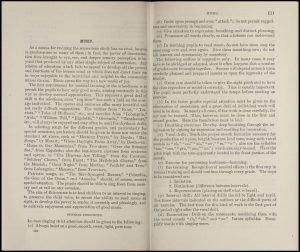
Tentative course of study for United States Indian schools. Prepared under the direction of commissioner of Indian affairs.1
In the 19th and 20th centuries, the United States was attempting to assimilate Native American students in the white American culture. This was done in part by placing Native American children in boarding schools, and by 1925, “over 357 boarding schools were being
operated in thirty states.”2 The United States government the education of Native American children was the key solution to assimilation. Since that is what the government believed, they also believed that “Only by complete isolation of the Indian child from his savage antecedents can he be satisfactorily educated.”3 A major part of the curriculum when assimilating Native American’s into white culture was music.
The document above is a few pages from a course study made for Native American boarding schools specifically focusing on the music aspect of their education. This document really emphasizes the importance of music in a young person’s education as music “develops all the powers and functions of the human mind.”4 This document lists some requirements in educating the students with music. The first requirement listed is that the students are only allowed to listen to “only hear good music, aiming consistently in this way to develop musical appreciation.”5 It proceeds to list selections that someone deemed “good” for the Native American students such as the march from the opera “Aida” and William Tell” but “rag time” music is not good since it is mostly enjoyed by the “average person”.6 This document states that these students should learn about music by Haydn and Mozart for special occasions, and special attention should be pay to patriotic songs such as “the Star-Spangled Banner.”7 It is stated that the purpose of this course study is to lead the children to “an interest in singing” and to “preserve” their voice, “secure the ability to read music at sight” and to perform it correctly and pleasantly, and “to cultivate enjoyment and appreciation of good music.”8
In many cultures, music is rooted into their tradition, especially oral tradition. In Native American culture, music is not simply a form of entertainment, it is an essential part of everyday life and ceremony. Where Western tradition focuses primarily on music in terms of entertainment at a distance, Native Americans view music as an active and personal experience, not simply something that is for personal entertainment.9
Bibliography
Bureau of Indian Affairs. 1915. Tentative course of study for United States Indian schools. Prepared under the direction of commissioner of Indian affairs, page 110-111. Available through: Adam Matthew, Marlborough, American Indian Histories and Cultures, http://www.aihc.amdigital.co.uk/Documents/Details/Ayer_386_U5_1915
The role of music in assimilation of students at … – gettysburg college. Accessed October 25, 2023. https://cupola.gettysburg.edu/cgi/viewcontent.cgi?article=1217&context=ghj.
Footnotes
1 Bureau of Indian Affairs. 1915. Tentative course of study for United States Indian schools. Prepared under the direction of commissioner of Indian affairs, page 110-111. Available through: Adam Matthew, Marlborough, American Indian Histories and Cultures, http://www.aihc.amdigital.co.uk/Documents/Details/Ayer_386_U5_1915
2 The role of music in assimilation of students at … – gettysburg college, accessed October 25, 2023, https://cupola.gettysburg.edu/cgi/viewcontent.cgi?article=1217&context=ghj.
3 The role of music in assimilation of students at … – gettysburg college, accessed October 25, 2023, https://cupola.gettysburg.edu/cgi/viewcontent.cgi?article=1217&context=ghj.
